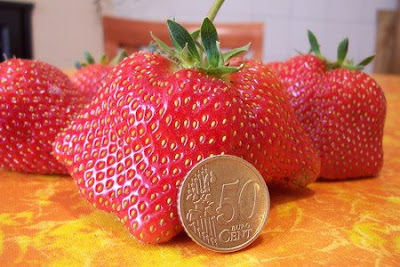My new Gurney's Whopper strawberries are growing large as advertised, but are an odd fan shape. Is this normal or am I doing something wrong? I have here a picture of Gurney's Whopper strawberries with a regular June-bearing strawberry plant for comparison.


-
4I am guessing that the Gurney's Whopper strawberries are exhibiting fasciation. You had some sweet potatoes with that issue last autumn. In my research for that answer, I stumbled across references that claimed that large strawberries are often fasciated. If I am able to find those references, I will post an answer.– Eric NitardyCommented May 8, 2012 at 7:26
-
@Eric: an example of the same phenomenon in dandelions.– Stefano BoriniCommented May 11, 2012 at 14:34
-
Those plants may be infected by some virus or bacteria, but I'm not sure with it. If you have a larger number of plants, of which only some have these symptoms, you should remove those few plants. As Eric wrote about your sweet-potato-issue from last autumn: did you plant the strawberries at the place, where those potatoes grew?– Christoph MühlmannCommented Jul 24, 2012 at 16:02
2 Answers
You did not anything wrong.
They are monstrouse strawberries, a genetic mutations favored by hormonal interventions

Often it is easy to meet, as a result of a degeneration of the tissue, drums that have abnormal forms or the set of main stem and branches follow irregular growths thus giving rise to so-called monstrosity. For fruits is the same. These phenomena due to various causes bacterial also lead to the formation of unique specimens.
This happens in many plants, most of all into fruits. Specimens twins, as in cherries, are very common.
In fruits, they disappeas quick, since are eaten. But in plants they rest evident, and more evident when the plant lives many years and support many many mutations. The cacti.
Occasionally cacti show aberrant growth forms - called "monstrous" forms, uncharacteristic of the species. An example of this is Aztekium hintonii forma mostruosa a very interesting, slow growing and uncommon plant in collections.
Aztekium hintoni Forma prolifera (mostruosus)

This is a genetically stable mutation with variable +/- monstrous, irregularly shaped, ribs with knobby-looking swellings along the stems. Stems are lightly pruinose and branches just from the base and occasionally at higher levels, the apexes easily. The areoles are white and woolly.
Cereus forbesii "spiralis"


Notocactus scopa "inermis" (mostruosa)

(source: cactus-art.biz)
"Catskill " is a very large wedge shaped strawberry that has been used to develop most modern varieties . It has mediocre flavor and sweetness but ships well ; shipping is the primary factor for commercial strawberry growers so the strong influence of Catskill. Anything I know, I got from U of IL Department of Agriculture brochure from the early 1970's. My opinion is that this fan shape is a further development of the Catskill line.
